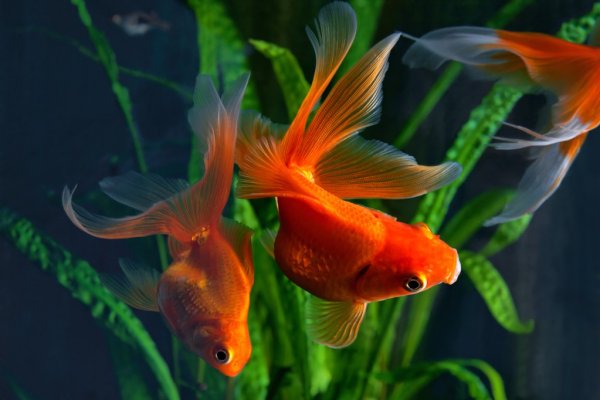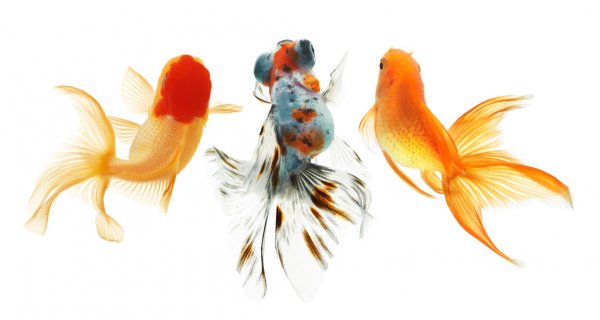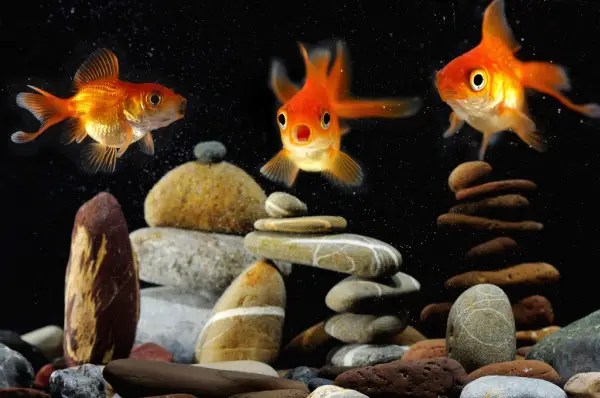Few things are as exciting as new fish day! Choosing a new goldfish is the first step in a relationship that can last decades with proper care. So let’s talk about how to choose a goldfish that you should bring home with you from the pet store!
Choosing a Healthy Goldfish
Always choose a goldfish that is swimming actively around the aquarium. Never select one lying on the bottom of the tank for extended periods, no matter how beautiful it may look. Lethargy is a sign of a deeper issue, such as poor water conditions.
The scales should be colorful and free of excess mucus. However, know a little about the breed you are considering since certain varieties may have odd-looking scales, including Pearlscale and Mirror.
Signs of Stress and Disease
When studying a possible pet goldfish in a pet store aquarium, look closely at its fins and body. Are the fins held upright and allowed to expand on occasion, or are the fins clamped and held closely to the body, as if stressed? Are there marks, including open wounds or missing scales, anywhere on the body of the fish?

Diseases like ich or velvet manifest as tiny spots of color on the fins and body. Fin rot and body fungus are also signs that a fish should be avoided. In fact, you should be careful buying any fish from a tank showing signs of ich or velvet because these diseases are contagious and will spread to your fish at home.
If the pet store aquarium shares water through a sump to every other tank in the store, which is common, I’d reconsider because the whole system is infected with the disease. You risk compromising the health of your personal aquarium for weeks by shopping there.
Common or Fancy Goldfish Goldfish?
If you don’t already have a particular goldfish variety in mind, then you may find yourself overwhelmed by the sheer variety of goldfish types for sale! Black moor, oranda, shubunkin, ryukin… An endless array of names spread across the aquariums. To grasp what’s available, we can divide goldfish into two main types: common goldfish and fancy goldfish.
Common varieties include comet goldfish, feeder goldfish, and the shubunkin. These types have the same streamlined body as their wild ancestors. Fancy goldfish include the black moor, oranda, ryukin, lionhead, and other varieties that have been bred for shapes like bulbous eyes or chunky backs.

Both kinds of goldfish are easy to care for, need the same water quality, and eat the same kinds of food. But fancy goldfish tend to be a little more sensitive to sudden shifts in temperature because they have been bred in tanks for decades. Their body plan is maximized for side viewing, as is common in aquariums.
Common goldfish do much better outdoors, where temperatures can change suddenly, and overwinter in ponds easily. They are also bred for being most pleasing when viewed from above (just like koi), as you’d expect for a pond!
Fancy goldfish are a little less disease resistant as well because they have been inbred to a high degree. Their genetic variation is less than that of common goldfish, which are more resistant to diseases. Still, it isn’t difficult to cure an illness your fancy goldfish develops with modern fish medications!
Other than that, both types are hardy and long-lived, so you should choose the goldfish type you will most enjoy seeing in your aquarium!
Does My Goldfish Need a Friend?
Goldfish aren’t really social fish. They will root around in the gravel and swim together on occasion. But more often, they are trying to get at a food source that another fish appears to have found. Goldfish usually take an interest in each other only when it is time to spawn.
So feel free to keep goldfish together if you want extra color and have a spacious enough tank! But goldfish aren’t especially social fish and don’t get lonely even if you keep your pet alone. It’s best to provide 10 gallons of space per adult goldfish, with a minimum of a 20-gallon tank for a fully grown fish.

No bowls! Remember, a healthy adult goldfish can be anywhere from 6 to 12 inches long, and they create a fair amount of waste. With their lack of proper circulation, filtration, and space, Goldfish bowls are out of the question!
How Can I Tell if My Goldfish is Male or Female?
Unfortunately, it is almost impossible to tell male goldfish from females when making a purchase at the pet shop. When they are ready to spawn, males grow distinctive white knobs called breeding tubercles along their heads and gill covers. Females may have a few but never as many as males.
Female goldfish begin to visibly swell with eggs. Even a female from a chunky breed like a black moor will be visibly thicker when ripe and ready to spawn. And any males in the tank will be chasing her around, rubbing their breeding tubercles along her belly to stimulate her.
Unless you’re lucky enough to be in the shop right as a breeding sign is visible, then you won’t be able to tell the sexes apart. The only way prospective goldfish breeders get their fish to spawn is to purchase and raise a few of them together until they naturally pair off!
Getting Your Goldfish Home Safely
So you’ve chosen a healthy, eager goldfish to bring home? Great! Just make sure that when the fish room employee bags your goldfish, they leave more air in the bag than water. They should know this, but many do not: air holds around 100 times as much oxygen as water. Therefore, the air volume is most important for the survival of your goldfish during the trip home. Never let a pet shop employee fill the bag entirely with water.
The flip side of this is that the low water volume means that it will cool extremely rapidly. If you have some shopping to do, that is fine. Simply ask to have the bag wrapped in newspaper, which acts as insulation. Goldfish are cold-water fish, but if it is winter outside, be certain not to linger as the water temperature could plunge dangerously low.
Summary
Choosing a new pet goldfish does not need to be a stressful process! Simply study the external signs, such as how a fish holds its fins, whether you see any marks, and how eager it is for food. And then, to transport it, make sure that the pet store employee places it in a bag properly, so there is enough space for air on the ride home! These tips will ensure that the goldfish you choose will live a long, healthy life in your tank for decades to come!
Related Reading:
- What Should You Do With an Unwanted Goldfish?
- Are Goldfish Prone for Seizures?
- What Tank Size Do I Need for 2 Goldfish?
- Panda Telescope Goldfish Info

